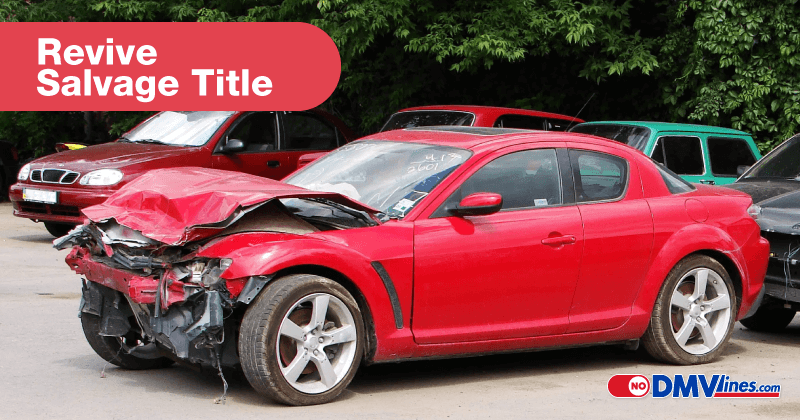Driving a vehicle with a salvage title takes a lot of work to pull off for many reasons. For instance, one must follow through a number of procedures. These with the intention of driving your vehicle legally. There are three types of salvage vehicles: Salvage, Revived, and Junk.
A junk vehicle is a vehicle that has an accident and the owner considers it too expensive to repair.
A Revived Salvage is a vehicle that has a report of total loss. Either reported by the owner or insurance company and then someone restores it.
How to Register a vehicle with a Salvage Title in CA?
In order to do that, here is a list of the things you will need:
- Apply for a Salvage Certificate.
- Complete an Application for Title or Registration (REG 343).
- Have the vehicle inspected by the DMV or CHP.
- Gather the appropriate paperwork and proof of ownership for your vehicle type
- Pay the $50 inspection fee, $5 prior history fee, and title/registration fees.
To register a salvaged car in CA, you will need :
- A completed Application for Title or Registration (Form REG 343), signed by all owners.
- Incorporate the cost of labor into the vehicle cost—even if the labor was performed by you.
- Proof of vehicle ownership, to include:
- A Salvage Certificate OR an Application for Salvage Certificate (Form REG 488C), completed and/or submitted with/within:
- 10 days of the settlement with your insurance company.
- A Statement of Facts (Form REG 256).
- The $2 record collection fee.
- The vehicle title OR an Application for Duplicate or Paperless Title (Form REG 227).
- A Salvage Certificate OR an Application for Salvage Certificate (Form REG 488C), completed and/or submitted with/within:
- EITHER a completed:
- Vehicle/Vessel Transfer and Reassignment (Form REG 262), IF you need to submit an odometer reading.
- Pick this up at your DMV office.
- Vehicle/Vessel Transfer and Reassignment (Form REG 262), IF you need to submit an odometer reading.
OR
- Bill of Sale (Form REG 135) AND Power of Attorney (Form REG 260), if you do not.
- A vehicle inspection performed by either:
- The California DMV, using a Verification of Vehicle (Form REG 31).
OR - The California Highway Patrol (CHP), using a CHP Certification of Inspection (Form CHP 97C).
- The California DMV, using a Verification of Vehicle (Form REG 31).
- An official Brake and Light Adjustment Certificate from a licensed repair shop. See below for more information.
- The appropriate fees (listed below).
If you’re re-registering a junked car, you’ll need:
- A completed:
- Application for Title or Registration (Form REG 343).
- Bill of Sale (Form REG 135).
- Power of Attorney (Form REG 260).
- A vehicle inspection with the DMV or CHP.
- The official Brake and Light Adjustment Certificate.
- The appropriate fees.
CA Salvage Certificate
Once a total loss settlement has been agreed upon, the insurance company (or its representative Salvage Pool) or the owner of the car must apply for Salvage Certificate within 10 days.
To apply for a Salvage Certificate, submit the following to the DMV:
- A completed Application for Salvage Certificate or Non-repairable Vehicle Certificate (Form 488C).
- Proof of ownership with a properly endorsed:
- Certificate of title.
- Application for Duplicate or Paperless Title (Form REG 227).
- NOTE: If proof of ownership is unavailable, in this case, the insurance company can apply for the Salvage Certificate.
- Any available bills of sale.
- Odometer disclosure (if there is no room on the title certificate).
- License plates.
- If you don’t have them, provide an explanation of the application.
- Vehicle verification, IF the title, is from out of state.
- Payment for the $20 Salvage Certificate fee.
NOTE: As shown above, you will need a salvage certificate. Important to realize, the Salvage Certificate can only be assigned to the insurance company of the owner or the car. Transfer of ownership can be executed on the Salvage Certificate once received.
Salvage Vehicle Inspections
With that in mind, also getting your salvaged car inspected is a mandatory part of reviving your vehicle for use in California.
You’ll have to make an appointment with either your local Department of Motor Vehicles office or a California Highway Patrol station.
While there, make sure to bring:
- Proof of ownership of the vehicle.
- The bill of sale, if relevant.
- Receipts for any repairs done on the car.
- The $50 inspection fee.
You will also need to obtain an official Brake and Light Adjustment Certificate from a state-licensed repair shop. Specific vehicles, such as motorcycles and large commercial vehicles, may require a certificate from a specialty repair shop.
California Fees for a Car with a Salvage Title
You may save money when purchasing a salvaged car, but bringing it back up to legal speed doesn’t come cheap.
Fees to re-register a car with a salvage title in California may include but are NOT limited to:
- Salvage vehicle inspection: $50.
- Salvage Certificate: $20.
- Registration: $46.
- Duplicate title: $20.
- California Highway Patrol fee: $23.
- Vehicle license fee (VLF): $20.
- Record collection fee: $2.
You may also be responsible for paying fees related to your vehicle’s:
- Specific county titling requirements.
- Weight.
- Smog check status.
- Title transfer.
- Prior history.
- Also, may be the case for substitute license plates.
